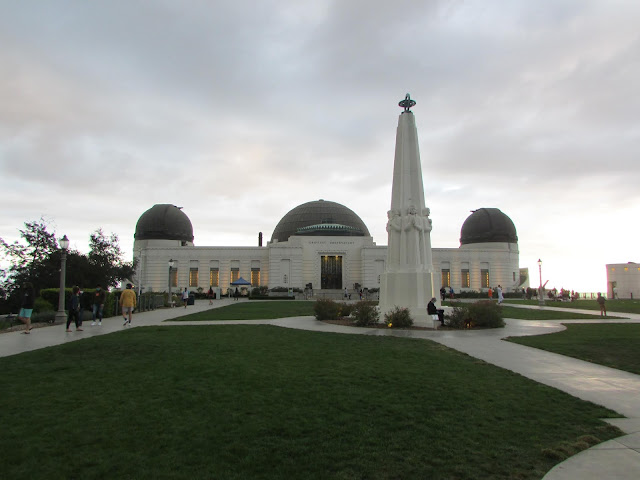This past weekend during our whirlwind trip to Los Angeles and Hollywood we packed up the family into rental SUV and traversed the winding roads out of Griffith Park to the historical Griffith Observatory.
When Terri and I lived in California we often traveled up to the observatory to soak in the history and enjoy the amazing vantage point where you have an unprecedented view of downtown Los Angeles as well as the famous Hollywood sign.
Here is your history:Griffith Observatory's unique architecture and setting, compelling programmatic offerings, and cinematic exposure have made it one of the most famous and visited landmarks in southern California. Tens of millions have come to walk the inside of the building, view the live planetarium shows, or simply gaze out towards the coast and the heavens. This cultural and scientific icon owes its existence to the dream of one man, Griffith Jenkins Griffith, and to the dedicated scientists and public servants who worked to fulfill his vision of making astronomy and observation accessible to all.Griffith's dream finally began to become reality in the spring of 1930, as the Griffith Trust (the governing board for the expenditures from the Griffith estate) enlisted some of the leading astronomers and scientists of the day as the core team planning the construction of Griffith Observatory. George Ellery Hale, who had overseen the creation of the great telescopes at Yerkes, Mount Wilson, and Palomar Observatories, used his knowledge to steer the overall design. Caltech physicist Edward Kurth drew up the preliminary plans and later guided the construction of the building. Russell W. Porter, the "Patron Saint" of the amateur telescope-making movement, was an invaluable aide to Kurth. In May of 1931 the Griffith Trust and Los Angeles Park Commissioners selected architects John C. Austin and Frederick M. Ashley to oversee the final plans for the new observatory building. Austin and Ashley hired Kurth to direct the project with Porter as consultant.Caltech and Mount Wilson engineers drew up plans for the Observatory's fundamental exhibits: a Foucault Pendulum, a 38-foot-diameter model of a section of the Moon sculpted by artist Roger Hayward, and a "three-in-one" coelostat (three tracking mirrors on one mount to feed three separate solar telescopes) so that the public could study the Sun in the Hall of Science. The Trust judged the 12-inch Zeiss refracting telescope as the best commercially available instrument of its kind and selected it to be used as the public telescope. A 75-foot-wide theater --one of the largest in the world -- was designed to hold a Zeiss planetarium projector. The planetarium had been invented in 1923, four years after Griffith's death, and his family agreed with the Trustees that it more fully honored his intent than the originally planned cinematic theater. The Observatory's planetarium was the third to be completed in the United States.
Groundbreaking for Griffith Observatory occurred on June 20, 1933, with the William Simpson Construction Company as the builder. While the building quickly took shape, Edward Kurth was tragically killed in a car accident in February 1934. The Griffith Trust brought in physicist Rudolph Langer to oversee the completion of the building, and Philip Fox, Director of the Adler Planetarium in Chicago, whose advice had been sought in the earliest phases of planning, was now increasingly involved with designing exhibits for the Hall of Science.
Griffith Observatory was shaped not only by the minds of scientists, but also by the times in which it was built. A major earthquake in Long Beach in March 1933 -- just as construction plans were being finalized -- led the architects to abandon the planned terra cotta exterior in favor of strengthening and thickening the building's concrete walls. Lower-than-usual prices caused by the Great Depression enabled the selection of the finest materials of the day for the interior walls, floors, and finishes, making the building both beautiful and durable. And a depression-era Federal public works program employed six sculptors to create a public sculpture at Griffith Observatory. The resulting Astronomers Monument, dedicated in November 1934, was hailed as one of the most important pieces of art to be completed by the program.
The dedication and formal opening of Griffith Observatory took place amid much fanfare on May 14, 1935. On that day, the Griffith Trust transferred ownership of the building to the City of Los Angeles; the City's Department of Recreation and Parks (called the ?Department of Parks? at the time of the transfer) has operated the facility ever since. From the moment the Observatory was opened to the public, those who served as full-time and part-time staff worked daily to fulfill the original vision of the Griffith Observatory as an educational and inspirational resource for all of society. - Source
The view of downtown Los Angeles from Griffith Observatory.
The view of the Hollywood sign from Griffith Observatory.
When we visit the Griffith Observatory, I always think of all the movies that have been filmed at the location. The one that stands out in my mind is the final scenes of the 1991 film The Roicketeer. I always liked that movie. But then again I haven't been able to get the vision of Jennifer Connelly in that white dress out of my mind. That may have something to do with it?
Oh and Rebel Without A Cause ...
If you are visiting Los Angeles I highly recommend traveling up to the Griffith Observatory. It's an experience you will never forget.
Check Out:




















No comments:
Post a Comment